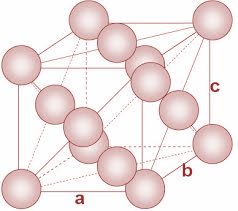
Aluminium has FCC structure. The edge length of the unit cell is 404pm If the density of the metal is $2.7gc{m^{ - 3}}$ , the molar mass (in $gmo{l^{ - 1}}$ ) of Al atom is:
A.28.20
B.30.40
C.26.80
D.25.20
Answer
216k+ views
Hint: An FCC unit cell contains atoms at all the corners of the crystal lattice and at the center of all the faces of the cube. Basically, the atom present at the face-centered is shared between two adjacent unit cells and only $\dfrac{1}{2}$ of each atom belongs to an individual cell.
Formula used:
$d = \dfrac{{zM}}{{{N_A}{a^3}}}$
Where d is the density
M is molar mass
a is edge length
${N_A}$ is Avogadro’s number
Z is the number of formula units in the unit cell.
Complete step by step answer:
In FCC unit cells, the atoms are present in all the corners of the crystal lattice. Moreover, there is an atom present at the center of every face of the cube. The structure is as shown:

Now, in the given question, we have to calculate the molar mass Al atom. We have been given the density and the edge length of the unit cell.
Now, density is $2.7gc{m^{ - 3}}$
Edge length i.e. a is 404pm
${N_A}$ i.e. Avogadro number is $6.023 \times {10^{23}}$
And z for FCC is $4$
So, according to the given formula,
$d = \dfrac{{zM}}{{{N_A}{a^3}}}$
By substituting the values, we get
$d = \dfrac{{4 \times M}}{{6.023 \times {{10}^{23}} \times {{(404 \times {{10}^{ - 10}})}^3}}}$
$2.7 = \dfrac{{4 \times M}}{{6.023 \times {{10}^{23}} \times {{(404 \times {{10}^{ - 10}})}^3}}}$
Therefore, $M = 26.80gmo{l^{ - 1}}$
Hence, option C is correct.
Note:The smallest replicating portion of a crystal lattice is known as a unit cell. They further exist in many types. The cubic crystal structure for example, consists of three distinct unit cell types i.e. plain cubic, face centered cubic and body centered cubic.
Formula used:
$d = \dfrac{{zM}}{{{N_A}{a^3}}}$
Where d is the density
M is molar mass
a is edge length
${N_A}$ is Avogadro’s number
Z is the number of formula units in the unit cell.
Complete step by step answer:
In FCC unit cells, the atoms are present in all the corners of the crystal lattice. Moreover, there is an atom present at the center of every face of the cube. The structure is as shown:

Now, in the given question, we have to calculate the molar mass Al atom. We have been given the density and the edge length of the unit cell.
Now, density is $2.7gc{m^{ - 3}}$
Edge length i.e. a is 404pm
${N_A}$ i.e. Avogadro number is $6.023 \times {10^{23}}$
And z for FCC is $4$
So, according to the given formula,
$d = \dfrac{{zM}}{{{N_A}{a^3}}}$
By substituting the values, we get
$d = \dfrac{{4 \times M}}{{6.023 \times {{10}^{23}} \times {{(404 \times {{10}^{ - 10}})}^3}}}$
$2.7 = \dfrac{{4 \times M}}{{6.023 \times {{10}^{23}} \times {{(404 \times {{10}^{ - 10}})}^3}}}$
Therefore, $M = 26.80gmo{l^{ - 1}}$
Hence, option C is correct.
Note:The smallest replicating portion of a crystal lattice is known as a unit cell. They further exist in many types. The cubic crystal structure for example, consists of three distinct unit cell types i.e. plain cubic, face centered cubic and body centered cubic.
Recently Updated Pages
Difference Between Alcohol and Phenol: Structure, Tests & Uses

Classification of Drugs in Chemistry: Types, Examples & Exam Guide

JEE Atomic Structure and Chemical Bonding important Concepts and Tips

JEE Amino Acids and Peptides Important Concepts and Tips for Exam Preparation

Electricity and Magnetism Explained: Key Concepts & Applications

Chemical Properties of Hydrogen - Important Concepts for JEE Exam Preparation

Trending doubts
JEE Main 2026: Application Form Open, Exam Dates, Syllabus, Eligibility & Question Papers

Derivation of Equation of Trajectory Explained for Students

Hybridisation in Chemistry – Concept, Types & Applications

Understanding the Angle of Deviation in a Prism

Understanding Collisions: Types and Examples for Students

How to Convert a Galvanometer into an Ammeter or Voltmeter

Other Pages
NCERT Solutions For Class 12 Chemistry Chapter 1 Solutions - 2025-26

NCERT Solutions for Class 12 Chemistry Chapter Chapter 7 Alcohol Phenol and Ether

NCERT Solutions ForClass 12 Chemistry Chapter Chapter 8 Aldehydes Ketones And Carboxylic Acids

JEE Advanced Marks vs Ranks 2025: Understanding Category-wise Qualifying Marks and Previous Year Cut-offs

Haloalkanes and Haloarenes Class 12 Chemistry Chapter 6 CBSE Notes - 2025-26

Solutions Class 12 Chemistry Chapter 1 CBSE Notes - 2025-26




